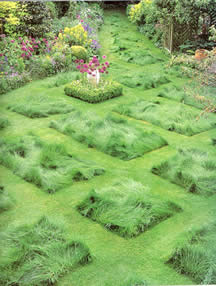 Tapis
Vert
Tapis
Vert
Green Carpets for Labyrinths, Mazes,
and Checkerboards
 Printable
PDF version
Printable
PDF version
If you’re inspired by the intricate creations
of crop artists who create “crop circles”
or even intricate portraits in large fields of grain
but just don’t have access to the space, consider
using a lawn as your “crop.” By employing
math and mowing, you can create labyrinths, mazes,
checkerboards, or abstract patterns turning a lawn
into a tapis vert or green carpet.
Time Required
Anywhere from an hour to many hours, depending on
the complexity of your design.
Directions
Lawn’s haven’t always been as they are
today, and the tradition of “lawn” varies
greatly among countries; in the United States they
are a common part of the home landscape. We first
hear of lawns in the 1200’s but then they were
most likely managed fields into which ornamental trees
and shrubs were planted. It was in France in the 1600’s
that grass was highly maintained to form what we now
consider to be lawn. The French called these tapis
vert or green carpets. Since then, the term tapis
vert has been used to describe lawns where grass is
mown at different heights to create patterns.

 Tapis
Vert
Tapis
Vert
